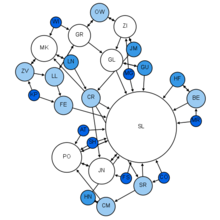Popular Social Networking Sites of the World
A social network is a social structure made up of a set of social actors (such as individuals or organizations), sets of dyadic ties, and other social interactions
between actors. The social network perspective provides a set of
methods for analyzing the structure of whole social entities as well as a
variety of theories explaining the patterns observed in these
structures.The study of these structures uses social network analysis to identify local and global patterns, locate influential entities, and examine network dynamics.
Social networks and the analysis of them is an inherently interdisciplinary academic field which emerged from social psychology, sociology, statistics, and graph theory. Georg Simmel authored early structural theories in sociology emphasizing the dynamics of triads and "web of group affiliations"Jacob Moreno is credited with developing the first sociograms
in the 1930s to study interpersonal relationships. These approaches
were mathematically formalized in the 1950s and theories and methods of
social networks became pervasive in the social and behavioral sciences
by the 1980s. Social network analysis
is now one of the major paradigms in contemporary sociology, and is
also employed in a number of other social and formal sciences. Together
with other complex networks, it forms part of the nascent field of network scie.
Social networking has been around forever. It's the simple act of
expanding the number of people you know by meeting your friends'
friends, their friends' friends and so on. In fact, many of us today use
Twitter and Facebook to promote our existing and upcoming businesses.
And people looking to connect with other business-associated contacts
usually move to sites like LinkedIn, but one need to understand that social media is beyond Twitter, Facebook, LinkedIn and Blogs.
After observing and running an analysis on hundreds of Social
Networking sites I have listed down 40 most popular social networks
across countries.
The social network is a theoretical construct useful in the social sciences to study relationships between individuals, groups, organizations, or even entire societies (social units, see differentiation). The term is used to describe a social structure determined by such interactions. The ties through which any given social unit connects represent the convergence of the various social contacts of that unit. This theoretical approach is, necessarily, relational. An axiom of the social network approach to understanding social interaction is that social phenomena should be primarily conceived and investigated through the properties of relations between and within units, instead of the properties of these units themselves. Thus, one common criticism of social network theory is that individual agency is often ignored although this may not be the case in practice (see agent-based modeling). Precisely because many different types of relations, singular or in combination, form these network configurations, network analytics are useful to a broad range of research enterprises. In social science, these fields of study include, but are not limited to anthropology, biology, communication studies, economics, geography, information science, organizational studies, social psychology, sociology, and sociolinguistics.
The social network is a theoretical construct useful in the social sciences to study relationships between individuals, groups, organizations, or even entire societies (social units, see differentiation). The term is used to describe a social structure determined by such interactions. The ties through which any given social unit connects represent the convergence of the various social contacts of that unit. This theoretical approach is, necessarily, relational. An axiom of the social network approach to understanding social interaction is that social phenomena should be primarily conceived and investigated through the properties of relations between and within units, instead of the properties of these units themselves. Thus, one common criticism of social network theory is that individual agency is often ignored although this may not be the case in practice (see agent-based modeling). Precisely because many different types of relations, singular or in combination, form these network configurations, network analytics are useful to a broad range of research enterprises. In social science, these fields of study include, but are not limited to anthropology, biology, communication studies, economics, geography, information science, organizational studies, social psychology, sociology, and sociolinguistics.
History
In the late 1890s, both Émile Durkheim and Ferdinand Tönnies foreshadowed the idea of social networks in their theories and research of social groups. Tönnies argued that social groups can exist as personal and direct social ties that either link individuals who share values and belief (Gemeinschaft, German, commonly translated as "community") or impersonal, formal, and instrumental social links (Gesellschaft, German, commonly translated as "society"). Durkheim gave a non-individualistic explanation of social facts, arguing that social phenomena arise when interacting individuals constitute a reality that can no longer be accounted for in terms of the properties of individual actors. Georg Simmel, writing at the turn of the twentieth century, pointed to the nature of networks and the effect of network size on interaction and examined the likelihood of interaction in loosely knit networks rather than groups.
Moreno's sociogram of a 2nd grade class







0 comments:
Post a Comment